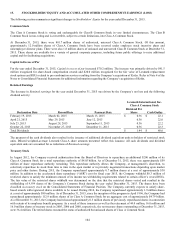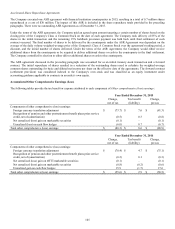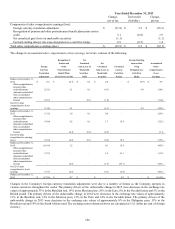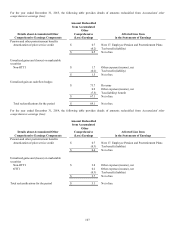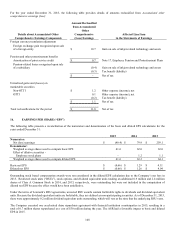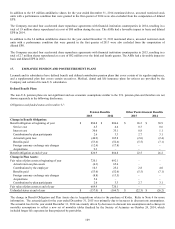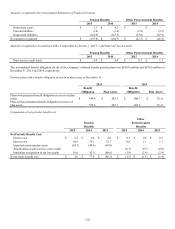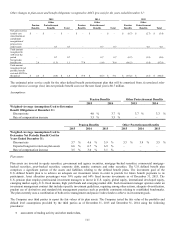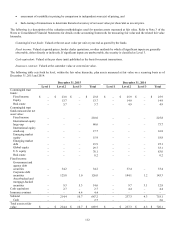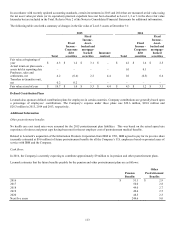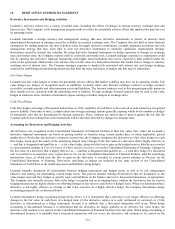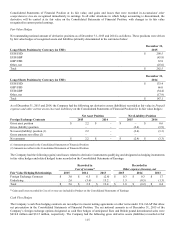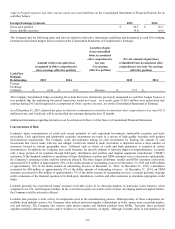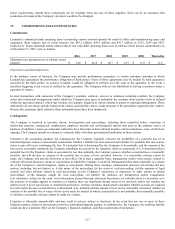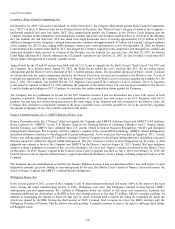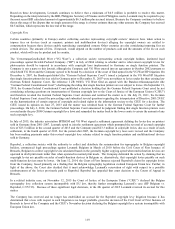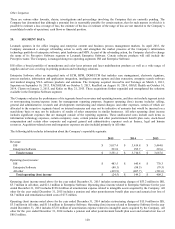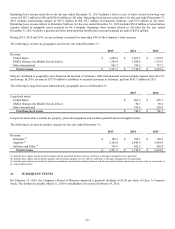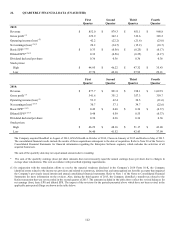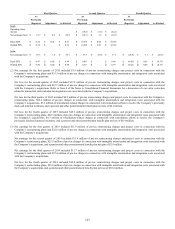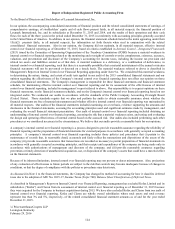Lexmark 2015 Annual Report Download - page 118
Download and view the complete annual report
Please find page 118 of the 2015 Lexmark annual report below. You can navigate through the pages in the report by either clicking on the pages listed below, or by using the keyword search tool below to find specific information within the annual report.114
18. DERIVATIVES AND RISK MANAGEMENT
Derivative Instruments and Hedging Activities
Lexmark’s activities expose it to a variety of market risks, including the effects of changes in foreign currency exchange rates and
interest rates. The Company’s risk management program seeks to reduce the potentially adverse effects that market risks may have on
its operating results.
Lexmark maintains a foreign currency risk management strategy that uses derivative instruments to protect its interests from
unanticipated fluctuations in earnings caused by volatility in currency exchange rates. The Company does not hold or issue financial
instruments for trading purposes nor does it hold or issue leveraged derivative instruments. Lexmark maintains an interest rate risk
management strategy that may, from time to time use derivative instruments to minimize significant, unanticipated earnings
fluctuations caused by interest rate volatility. By using derivative financial instruments to hedge exposures to changes in exchange
rates and interest rates, the Company exposes itself to credit risk and market risk. Lexmark manages exposure to counterparty credit
risk by entering into derivative financial instruments with highly rated institutions that can be expected to fully perform under the
terms of the agreement. Market risk is the adverse effect on the value of a financial instrument that results from a change in currency
exchange rates or interest rates. The Company manages exposure to market risk associated with interest rate and foreign exchange
contracts by establishing and monitoring parameters that limit the types and degree of market risk that may be undertaken.
Fair Value Hedges
Lexmark uses fair value hedges to reduce the potentially adverse effects that market volatility may have on its operating results. Fair
value hedges are hedges of recognized assets or liabilities. Lexmark enters into forward exchange contracts to hedge accounts
receivable, accounts payable and other monetary assets and liabilities. The forward contracts used in this program generally mature in
three months or less, consistent with the underlying asset or liability. Foreign exchange forward contracts may be used as fair value
hedges in situations where derivative instruments expose earnings to further changes in exchange rates.
Cash Flow Hedges
Cash flow hedges are hedges of forecasted transactions or of the variability of cash flows to be received or paid related to a recognized
asset or liability. From time to time, Lexmark enters into foreign exchange options generally expiring within twelve months as hedges
of anticipated sales that are denominated in foreign currencies. These contracts are entered into to protect against the risk that the
eventual cash flows resulting from such transactions will be adversely affected by changes in exchange rates.
Accounting for Derivatives and Hedging Activities
All derivatives are recognized in the Consolidated Statements of Financial Position at their fair value. Fair values for Lexmark’s
derivative financial instruments are based on pricing models or formulas using current market data, or where applicable, quoted
market prices. On the date the derivative contract is entered into, the Company designates the derivative as a fair value hedge or a cash
flow hedge, based upon the nature of the underlying hedged item. Changes in the fair value of a derivative that is highly effective as
— and that is designated and qualifies as — a fair value hedge, along with the loss or gain on the hedged asset or liability are recorded
in current period earnings in Cost of revenue or Other expense (income), net on the Consolidated Statements of Earnings. Changes in
the fair value of a derivative that is highly effective as — and that is designated and qualifies as — a cash flow hedge of a forecasted
sale is recorded in Accumulated other comprehensive loss on the Consolidated Statements of Financial Position, until the underlying
transactions occur, at which time the loss or gain on the derivative is recorded in current period earnings in Revenue on the
Consolidated Statements of Earnings. Derivatives qualifying as hedges are included in the same section of the Consolidated
Statements of Cash Flows as the underlying assets and liabilities being hedged.
Lexmark formally documents all relationships between hedging instruments and hedged items, as well as its risk management
objective and strategy for undertaking various hedge items. This process includes linking all derivatives that are designated as fair
value hedges and cash flow hedges to specific assets and liabilities on the balance sheet or to forecasted transactions, as appropriate.
The Company also formally assesses, both at the hedge’s inception and on an ongoing basis, whether the derivatives that are used in
hedging transactions are highly effective in offsetting changes in fair value or cash flows of hedged items. When it is determined that a
derivative is not highly effective as a hedge or that it has ceased to be a highly effective hedge, the Company discontinues hedge
accounting prospectively, as discussed below.
Lexmark discontinues hedge accounting prospectively when (1) it is determined that a derivative is no longer effective in offsetting
changes in the fair value or cash flows of a hedged item, (2) the derivative expires or is sold, terminated or exercised, or (3) the
derivative is discontinued as a hedge instrument, because it is unlikely that a forecasted transaction will occur. When hedge
accounting is discontinued because it is determined that the derivative no longer qualifies as an effective fair value hedge, the
derivative will continue to be carried on the Consolidated Statements of Financial Position at its fair value. When hedge accounting is
discontinued because it is probable that a forecasted transaction will not occur, the derivative will continue to be carried on the


